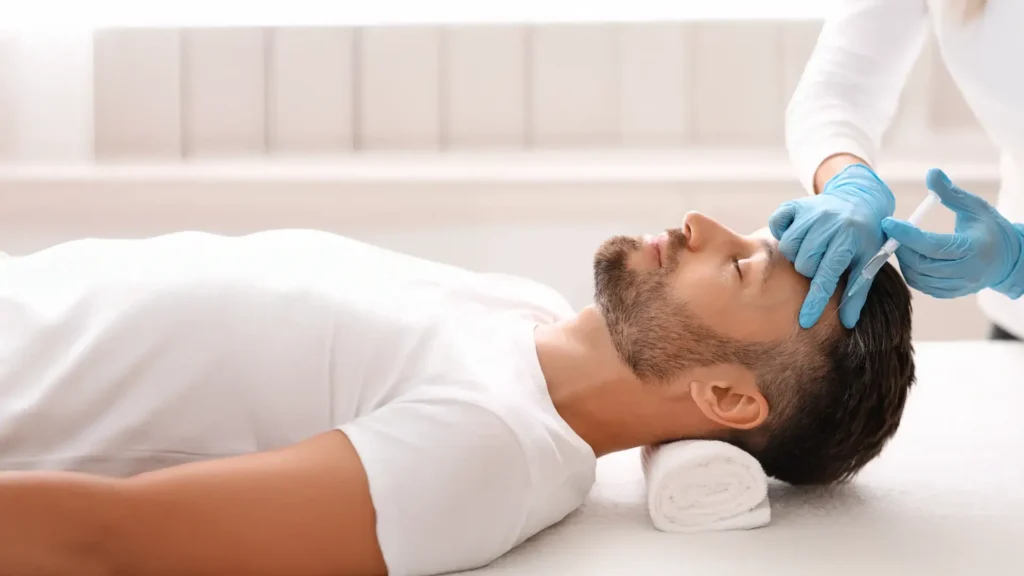Male pattern baldness, or androgenetic alopecia, is the leading cause of hair loss in men, affecting up to 50% of men over the age of 50. While it’s a natural part of aging for many, it can impact confidence and self-image. Understanding the symptoms, progression, and available solutions is key to managing it effectively.
What Is Male Pattern Baldness?
Male pattern baldness is a genetic condition influenced by hormones—particularly dihydrotestosterone (DHT). This hormone causes hair follicles to shrink over time, resulting in shorter, finer hairs and eventually, complete follicle dormancy (no hair growth).
Common Symptoms
Early detection is crucial for slowing or reversing hair loss. Watch for these signs:
1. Receding Hairline
One of the first symptoms is a gradual recession at the temples, forming an “M” shape on the forehead.
2. Thinning at the Crown
The crown (top/back of the scalp) becomes visibly thinner, often before you even notice it in the mirror.
3. Widening Part Line
As hair density decreases, the part line may appear wider or more prominent.
4. Overall Hair Thinning
Hair becomes finer and less voluminous across the top of the scalp while remaining dense on the sides and back.
5. Slow Hair Growth
Affected follicles produce hair more slowly and in shorter growth cycles.
Stages of Male Pattern Baldness (Norwood Scale)
Doctors use the Norwood-Hamilton Scale to classify the severity and pattern of male hair loss:
| Stage | Description |
|---|---|
| Stage 1 | Minimal to no hair loss. |
| Stage 2 | Receding hairline at temples (early “M” shape). |
| Stage 3 | Deepening of the hairline recession; visible thinning. |
| Stage 4 | Significant recession and thinning at the crown. |
| Stage 5 | Bald areas at the crown and temples begin to merge. |
| Stage 6 | Bridge of hair between bald areas disappears. |
| Stage 7 | Only a horseshoe-shaped ring of hair remains around the sides and back of the head. |
Causes of Male Pattern Baldness
- Genetics: A family history of baldness increases your risk.
- Hormones: Sensitivity to DHT leads to follicle shrinkage.
- Age: The risk and severity increase with age.
- Health & Lifestyle: Poor diet, stress, smoking, and underlying conditions can worsen hair loss.
Treatment Options
1. Medications
- Minoxidil (Rogaine)
A topical treatment that stimulates blood flow to the scalp and prolongs the hair growth phase. Available over the counter. - Finasteride (Propecia)
A prescription oral medication that inhibits DHT production. Clinically proven to reduce hair loss and even regrow hair in some men.
2. Hair Transplant Surgery
- FUT (Follicular Unit Transplantation): A strip of scalp is removed, and follicles are transplanted to thinning areas.
- FUE (Follicular Unit Extraction): Individual follicles are extracted and transplanted. Minimally invasive with less scarring.
3. Platelet-Rich Plasma (PRP) Therapy
A non-surgical treatment where your blood is drawn, processed, and injected into the scalp to stimulate hair growth naturally.
4. Low-Level Laser Therapy (LLLT)
Laser devices stimulate hair follicles and improve circulation. FDA-cleared and safe for home use or in-clinic sessions.
5. Lifestyle Changes
- Eat a balanced, nutrient-rich diet with iron, biotin, zinc, and protein.
- Quit smoking—it restricts blood flow to follicles.
- Manage stress—chronic stress can accelerate hair loss.
6. Hair Loss Concealers
Cosmetic solutions like hair fibers, scalp micropigmentation, and volumizing shampoos can improve appearance while undergoing treatment.
When to See a Specialist
If you’re noticing thinning or excessive shedding, consult a dermatologist or hair restoration specialist. Early intervention significantly improves outcomes. They can:
- Determine the cause
- Evaluate your Norwood stage
- Recommend a tailored treatment plan
Final Thoughts
Male pattern baldness is a progressive but manageable condition. Thanks to advances in hair restoration science, men today have more options than ever to retain, restore, or replace lost hair.
The earlier you take action, the more hair you can preserve. Don’t wait for the hairline to recede further—talk to a professional and reclaim your confidence.




